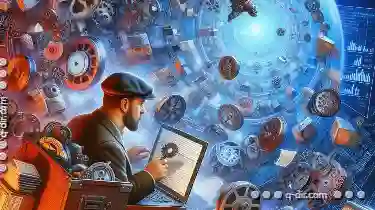When it comes to copying files between different drives, whether they are internal or external, there are several potential pitfalls that can occur. ...
 Understanding these issues is crucial for ensuring a smooth and error-free file transfer process. In this blog post, we will explore some of the common problems that may arise when copying files between drives and provide solutions to mitigate these issues.
Understanding these issues is crucial for ensuring a smooth and error-free file transfer process. In this blog post, we will explore some of the common problems that may arise when copying files between drives and provide solutions to mitigate these issues.1. Sub-points:
1.) Sub-points:
1. File System Mismatch
Issue: Different operating systems use different file systems. For example, Windows typically uses NTFS or FAT32, while macOS and Linux often use HFS+ or ext4. When copying files between drives with incompatible file systems, the operating system may not recognize the other file system, leading to errors during the copy process.
Solution: Use a compatible file system when formatting an external drive. For instance, if you are transferring files from a macOS drive to a Windows computer, format the drive as FAT32 or exFAT using macOS or a third-party tool like Disk Management in Windows. This ensures that both systems can read and write to the drive without issues.
2. Permissions and Access Rights
Issue: File permissions and access rights are set by default depending on the user account you use to copy the files. If the destination drive is mounted under a different user account, it may lack necessary permissions to access certain files or folders, resulting in errors during copying.
Solution: Ensure that the user account used to mount the external drive has read and write privileges for all the files and folders intended to be copied. You can adjust file permissions on both Windows and macOS using built-in tools like File Explorer in Windows or Finder in macOS.
3. Incompatible File Formats
Issue: Some applications generate proprietary file formats that may not be supported by other operating systems or software, leading to errors when copying these files between drives.
Solution: Convert the incompatible file format to a widely-supported one (e.g., from Adobe Photoshop's PSD format to JPEG) before transferring them. There are numerous free and paid tools available online that can assist with this process, such as Zamzar or OnlineConvertFree.
4. File Corruption
Issue: Data corruption may occur if the copying process is interrupted, especially when dealing with large files or network-attached storage devices. This results in incomplete copies that are either partially copied or corrupted.
Solution: Use reliable and fast connections to minimize interruption during the copy process. Ensure you have a stable internet connection when transferring files over a network drive. Also, consider using tools like Robocopy for Windows, which offers features such as retry mechanisms and error handling.
5. File Size Limitations
Issue: Some file systems or external drives may impose limitations on the size of individual files that can be copied to them. For example, NTFS allows copying large files (up to 4GB) directly without any issues, but FAT32 has a limit and might require splitting larger files into smaller chunks.
Solution: Verify the compatibility of your destination drive with the file sizes you plan to copy. If necessary, use compression tools like WinZip or 7-Zip to split large files into manageable parts before copying them to an incompatible drive, then recompress them on the other side after transfer.
6. Drive Compatibility Issues
Issue: Some external drives may not be compatible with certain computers due to USB ports, Thunderbolt, FireWire, or other interfaces that do not support the full speed of the device. This can lead to slower data transfer rates and potential errors during copying.
Solution: Check the specifications of both your computer and the external drive to ensure compatibility before attempting a file copy operation. You may also consider using an adapter cable if needed, especially for older or less powerful computers.
7. Virus and Malware Scanning
Issue: When transferring large numbers of files between drives, there is a risk that some malicious software (viruses, malware) on the source drive might be detected by security programs running on your computer or device. This can lead to interruptions during copying processes.
Solution: Perform virus and malware scans on both the source and destination drives before initiating any file transfer operations. If necessary, temporarily disconnect the external drive from other devices or networks until the scan is completed.
Conclusion
Copying files between different drives can be a simple task if you're aware of potential issues that may arise due to system differences, file formats, and hardware compatibility. By taking into consideration these factors and knowing how to troubleshoot them, you should be able to minimize errors and ensure successful file transfers across various storage devices.

The Autor: / 0 2025-02-23
Read also!
Page-

Details View for External Drives: Optimization Tips
When it comes to managing and accessing external storage devices, ensuring that the details view is both functional and optimized can significantly ...read more

Email Attachment Size Limits Explained
Email attachments are an essential part of communication, allowing users to share documents, images, and other files easily. However, there are often ...read more

Details View in Virtual Machines: Setup Guide
One such tool that enhances this management process is the "Details View" feature. This blog post will delve into understanding what a Details View ...read more